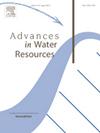Experimental validation of an image-based dynamic pore-network model for spontaneous imbibition in sandstones
IF 4
2区 环境科学与生态学
Q1 WATER RESOURCES
引用次数: 0
Abstract
Spontaneous imbibition (SI) in porous media driven by capillary action is pivotal to many subsurface and industrial applications. The pore-scale modeling has been playing a vital role in unraveling wetting dynamics in pore spaces, which will eventually determine flow parameters and behaviors. In this paper, we mainly contribute to validating an image-based dynamic pore-network model (PNM) for SI. For the scenario of water imbibing into dry porous media, we measured imbibition rates and residual saturations of three types of sandstones, namely, Nubian, Bentheimer and Upper Berea as the validation data. Then, we extracted the pore networks of the CT images of the same core samples used in the lab experiments, to reduce heterogeneity uncertainties. We demonstrate that using either a uniform or a lognormal distribution of effective contact angles that is consistent with experimental measurements in the literature, the dynamic PNM can accurately predict experimental imbibition rates and residual saturations. Given the challenge of experimentally determining effective contact angles, we further investigate the effects of these two plausible contact angle distributions on the predictions of pore-scale wetting events, relative permeability, capillary pressure, and imbibition rates for more viscous nonwetting fluids. Although uncertainties remain in the preset of effective contact angles, we show that the validated dynamic PNM can provide quantitative and valuable insights into pore-scale wetting dynamics.
基于图像的砂岩自吸动态孔隙网络模型的实验验证
由毛细作用驱动的多孔介质中的自发渗吸(SI)是许多地下和工业应用的关键。孔隙尺度建模在揭示孔隙空间的润湿动力学中起着至关重要的作用,最终将决定流体的流动参数和行为。在本文中,我们主要致力于验证基于图像的SI动态孔隙网络模型(PNM)。在干燥多孔介质吸水情景下,我们测量了努比亚、Bentheimer和Upper Berea三种类型砂岩的渗吸速率和残余饱和度作为验证数据。然后,我们提取了实验室实验中使用的相同岩心样品的μCT图像的孔隙网络,以减少异质性不确定性。我们证明,使用与文献中实验测量一致的均匀或对数正态分布的有效接触角,动态PNM可以准确地预测实验吸胀率和剩余饱和度。考虑到实验确定有效接触角的挑战,我们进一步研究了这两种貌似合理的接触角分布对孔隙尺度润湿事件、相对渗透率、毛管压力和更粘性非润湿流体吸胀率预测的影响。尽管在有效接触角的预设中仍然存在不确定性,但我们表明,经过验证的动态PNM可以为孔隙尺度的润湿动力学提供定量和有价值的见解。
本文章由计算机程序翻译,如有差异,请以英文原文为准。
求助全文
约1分钟内获得全文
求助全文
来源期刊

Advances in Water Resources
环境科学-水资源
CiteScore
9.40
自引率
6.40%
发文量
171
审稿时长
36 days
期刊介绍:
Advances in Water Resources provides a forum for the presentation of fundamental scientific advances in the understanding of water resources systems. The scope of Advances in Water Resources includes any combination of theoretical, computational, and experimental approaches used to advance fundamental understanding of surface or subsurface water resources systems or the interaction of these systems with the atmosphere, geosphere, biosphere, and human societies. Manuscripts involving case studies that do not attempt to reach broader conclusions, research on engineering design, applied hydraulics, or water quality and treatment, as well as applications of existing knowledge that do not advance fundamental understanding of hydrological processes, are not appropriate for Advances in Water Resources.
Examples of appropriate topical areas that will be considered include the following:
• Surface and subsurface hydrology
• Hydrometeorology
• Environmental fluid dynamics
• Ecohydrology and ecohydrodynamics
• Multiphase transport phenomena in porous media
• Fluid flow and species transport and reaction processes
 求助内容:
求助内容: 应助结果提醒方式:
应助结果提醒方式:


